Thursday, August 18, 2005
Book 18: After the Quake, by Haruki Murikami
Publisher: Vintage; Vintage edition (May 13, 2003)
Americans may find all too familiar the angst haunting the characters in Haruki Murikami´s collections of six stories, After the Quake. In each story, a tumultuous event provides ample reason for buried fears to rise to the surface consciousness of the an individual character. In one instance, catastrophe escaltes the progres of a love stalled by years of friendship. In another, the earthshaking event leads a woman to reconsider her life and her punctuated hatred of her ex-husband. But in all the story, Murikami´s characteristic masterful use of simple language for profound ends allows the author evoke a sensitivity and passion in not just his characters, but the reader as well.
Murikami is perhaps the foremost Japanese novelist. His works include Hard-Boiled Wonderland and the End of the World along with the novel generally regarded as his masterpiece, The Wind-Up Bird Chronicle. But After the Quake, provides a rare glimpse of the novelist in short story form. It is a glimpse full of promise and reward and thoughts with a universal applicability.
Americans may recognize the scnearios faced by Murikami´s characters, but few will have deep knowledge of the tragedy involved. The Kobe earthquake wrought havoc on the Japanese city when it struck in 1995, measuring a devastating 6.9 on the Richter scale. It had the same type of effect on Japanese life as 9/11 did for many Americans. What had seemed stable was suddenly undermined and frighteningly ephemeral. What foundations were left? Who was to blame, how to prevent another such tragedy, when the "enemy" was so evasive? It is the fear of living that Murikami tackles in the foremost, his six stories exploring how people come to deal with fear and go on living even as they are forced to realize every moment could be their last.
Unlike many short story collections, each story in After the Quake is a unique entity on its own, while tying into the work´s larger thematic emphasis. In "Frog Saves Tokyo", the main character is beset upon by a Gregor Samsa like gigantic Frog to battle the devil earthwarm that will cause an earthquake beneath Tokyo like no natural disaster before. However, in the longest story, "Honey Pie", Murikami is much less fantastical, dealing with love and the classic Hamlet paradox of inaction versus action. Fear, whether personal or in the form of a potential destroyer, may lead us to turn in ourselves to seak safety, but disengaging from the world rarely provides us with the answers we´re looking for. In the end, what arises most from Murikami´s wonderful and entertaining stories are the human ability to persevere despite horrendous circumstances and a willingness to face life head on. As his stories suggest, Murikami sees avoiding life as being as frightful as anything mother nature can muster.
Friday, August 12, 2005
Restaurant 62: King Louie's (St. Louis, Missouri)
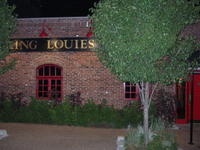 RESTAURANT: King Louie’s
RESTAURANT: King Louie’sLOCATION: 3800 Chouteau, Saint Louis, Missouri
DATE: August 6, 2005
FOOD: Seared gnocchi with brown butter, mushrooms, and pistachio; roasted mushroom Flatbread, thyme, goat cheese; King Louie’s Salad: Dried Cherries, Pears, Toasted Walnuts, gorgonzola; Yellowfin Tuan with syrah reduction and seafood sausage; Beggar’s Purse: Chocolate-Cherry Walnut Tart with caramel ice cream
BEVERAGE: Martini, up with lime; Split a bottle of Lawson’s Dry Hills Sauvignon Blanc – Marlborough; Coffee
PRICE: $190.00 (for two)
We were on our way to see the King. Libby and I, mixes of anxiety and anticipation, held hands to calm ourselves as we approached his castle. We had broached the fortress during an October night nearly a year before, but that night, then as now, was more waking fantasy than reality, a surreal entwining of personal happiness and public pleasures.
Now a visit to see the King is not something to be entered into lightly. First, and perhaps most importantly, King Louie does not share the foolishness of a certain other emperor. You will not see Louie walking around his castle naked. Consequently, this means none of the guests are allowed to sport “new clothes” either. Louie isn’t asking for suits and ties, but the man’s a King for Christ’s sake, and attire fitting his majesty is the surest way to begin and stay on his good side.
Immersed in nervous conversation so as to avoid the subject on both of our minds, we arrived at King Louie’s before we had time to second guess ourselves. The King’s, the King’s. There was no mistaking it – any thought that we had taken a wrong turn somewhere along Chouteau was quickly dispelled by the castle’s sign “King Louie’s”. We were in the right place.
Trying to summon courage from somewhere deep in the smythie of our souls, we fearlessly left the tiny Honda behind and walked towards the castle’s drawbridge, beautifully ablaze in an otherwise serene nightscape. But the bravery suddenly faded. Had we remembered the second most important thing before visiting the King? We stopped walking and listened. For moments there was nothing. Just silence, silence as black as the night around us. But then we heard it. At first softly, it grew, until there was no mistaking the joyous cacophony echoing from our bellies. We had remembered to arrive hungry! No fear, we would be able to handle a feast fit for a king.
Our last hesitancies cast aside like a worn-out court jester, we charged ahead, across the drawbridge and the perilous moat beneath. We entered the castle and relief washed over us like a wave. The dark wood, the romantically lit rooms – it was just as before. The recognition sparked a sense of safety, of coming home. I turned to Libby, and the look in her eyes was unmistakable – this was exactly where we needed to be.
But there was one more hurdle to jump before we reached the King. Inside or out, the question loomed like the threat of a foreign invader? Inside or out? Inside was familiar and peaceful, but the outside had that slick summer buzz of outdoor barbeques and fireflies. Where would we find the true King and not an imposter?

With a bold determination, I forged ahead to the outdoor patio, only to realize we would never find the King this way. While there was no doubt an enjoyable evening would have ensued, outside presented only a limited version of the King’s greatness. Libby and I had come for the real thing. So we beat a hasty retreat, lavishing apologies upon the cute and friendly courtier, who succumbed to our charms and seated us in the King’s main banquet hall, far away from the maddening crowd that had also come that evening to see royalty at work.
We settled into an uneasy calm. Would there be any more tests? Had we finally surpassed the last of the obstacles? As if a genie from a lamp, one of the King’s most trusted advisors appeared by our table. Courteous and knowledgeable, with a practiced air about him, the advisor immediately set our minds to rest. Yes, it was okay to relax. We belonged here with the King and everything was going to be alright.
From that point forward, the evening progressed without hiccup. Having remembered to pack our appetites, nothing the King threw at us was the least bit daunting. The King was clearly well traveled. Using influences from all over the world, he presented us with enough options during his banquet for meals to come ad infinitum. However, as we were concerned only about the one directly before us, we solicited the goodwill of our aide-de-camp and his recommendations were as flawless as Cleopatra’s were divisive.
The King pulled out all the stops. He began his display of marvels with a funghi exhibition of unexpected and tempting delights. His thyme flatbread, loaded with goat cheese and enough mushrooms for an entire kingdom’s harvest, was superb. The bread had the charcoaled lining of wood oven pizza and while it may have been my imagination, some incendiary bit of the fire’s heat seemed to dance amongst the bread’s surface.
Equally compelling was the mushroom gnocchi. Perhaps when you’re King, it’s easier to ignore convention than it is for the rest of us plebeians. Whatever the reason, Louie’s gnocchi was a shocking fusion of American technique with Italian heritage. Seared like a scallop, his gnocchi had the buttery richness of a sauté, but with the dense potato flavor one desires in gnocchi. The mushrooms were the ideal compliment to the gnocchi’s splendor and if Louie had forced us to leave then, we would have exited with contentment etched across our faces.
But Louie still had some tricks up his sleeve. Quite obviously, any salad officially given the name of the King is going to produce fireworks. Sweet cherries sparked our mouths when coupled with the softened pears, candied walnuts, and pungent blue cheese of the salad. The salad was an epiphany of sorts – while fruit, cheese and nut salads have become as commonplace as bad political leadership, Louie reminded us why the salads gained notoriety in the first place. His salad deserved its praised title.
During all of the food, our lips were lapped by the nectar of the gods, a personally selected and aromatic white wine from the distant land of Oceana. The wine’s intense grapefruit flavor meshed well with our food, and Louie proved himself not to be a connoisseur of food alone.
With all the devotees having flocked to the castle that Saturday evening, the one mistake during our meal was understandable, if not downright forgivable. For the same amazing yellowfin tuna I had ordered my previous visit to see his greatness, this time was a bit dry around the edges. Enhanced by seafood sausage and the brazen use of mashed potatoes with fish, Louie provided enough successful side shows to make up for the slightly overcooked nature of the tuna. With such a wide dominion to look after, I’m hopeful he attends to his ports and waterways with more care next time.
Even as Libby and I patted our stomachs, near full and
 entirely satisfied, Louie had one more spectacle for us to behold. The King is known for his humor, so his tongue and cheek labeling of his prized dessert as the “beggar’s purse” is an act of levity that comes from some many years of sagacious rule. Composed of a flaky, pie like dough, the “purse” enclosed a mind-blowing lava of melted dark chocolate, walnuts, and cherries, the last of which provided a tartness of scintillating proportions. Never had chocolate tasted like this, sweet and sour fused into one panoramic whole.
entirely satisfied, Louie had one more spectacle for us to behold. The King is known for his humor, so his tongue and cheek labeling of his prized dessert as the “beggar’s purse” is an act of levity that comes from some many years of sagacious rule. Composed of a flaky, pie like dough, the “purse” enclosed a mind-blowing lava of melted dark chocolate, walnuts, and cherries, the last of which provided a tartness of scintillating proportions. Never had chocolate tasted like this, sweet and sour fused into one panoramic whole.The King seemed to be smiling. We had graced his majesty’s presence without embarrassing ourselves, but with our acute awareness, we knew it was time to depart. Holding hands once again, this time out of joy rather than apprehension. Embracing in the moonlight, Libby and I felt, even if for that fleeting moment only, what it would be like to be King. The only way to describe that feeling is to quote Mel Brooks: “It’s good to be king.”
RATING: 8.5/10
Thursday, August 11, 2005
Just Desserts 14: Annapolis Ice Cream Company (Annapolis, Maryland)

RESTAURANT: Annapolis Ice Cream Company
LOCATION:196 Main Street, Annapolis, Maryland
DATE: August 2, 2005
DESSERT: Sundae with a scoop of Raspberry Chocolate and a scoop of Chocolate Chip Vanilla, topped with Heath Bar pieces, Slivered Almonds, and Whipped Cream; Cone with one scoop of Blackberry Cobbler ice cream.
BEVERAGE: Tap Water
PRICE: $5.50
There were no barbershop quartets. No nickel shoe shines or candy stripers either. A sign even advertised flavors including cake batter and green tea. Unless Bazz Larhman was directing a remake of American Graffiti, there really wasn’t any reason to think that Annapolis Ice Cream Company was in anyway hinting at some great Americana nostalgia. Yet, unmistakably, it was.
Take, for instance, the linoleum floors. One part Norman Rockwell, one part America that never was (though the two are truly one and the same), the floors hinted at that clean simplicity with which Americans like to view their past. Or, if further examples are needed, take the dreamy-eyed teenagers who scooped and smiled with the naïve air of unlimited expectations. Had they never heard of irony, did they not realize the cruel reality of the world?
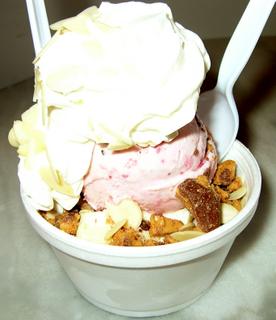 But it wasn’t one thing specifically that evoked the America of the G.I. Bill, economic optimism, and entrenched segregation; it was the cumulative effect that made the atmosphere of Annapolis Ice Cream Factory so anachronistic. Almost as if the place had Rip Van Winkled its way through the last half-century, awakening in a time when every dunk of an Oreo brought with it hearty amounts of trans fat, a time when ice cream shops needed to set out disclaimers stating that in the interests of health, ice cream was best enjoyed in moderation.
But it wasn’t one thing specifically that evoked the America of the G.I. Bill, economic optimism, and entrenched segregation; it was the cumulative effect that made the atmosphere of Annapolis Ice Cream Factory so anachronistic. Almost as if the place had Rip Van Winkled its way through the last half-century, awakening in a time when every dunk of an Oreo brought with it hearty amounts of trans fat, a time when ice cream shops needed to set out disclaimers stating that in the interests of health, ice cream was best enjoyed in moderation.Such a sign does in fact hang in Annapolis Ice Cream Company, yet another eclectic leveling of time and place to satisfy even the most demanding post-modern stomach. However, even with the double-codings and the shadow of Frederic Jameson hanging over the freezers like an academic Frankenstein, the actual product the store churns out is less Pynchon and more Potter, as in Harry, being one of life’s simple, but seemingly inexhaustible pleasures.
Though the flavors were more mundane than the concoctions of Chinatown Ice Cream Factory or the gelato of Otto (oh sweet Olive Oil, how I miss thee), Annapolis Ice Cream Company did very well with dessert ubiquities. The raspberry chocolate was more fruit than cocoa, possessing a tartness more reminiscent of a chocolate raspberry martini than dairy decadence. The chocolate came in such minute pieces, like those used in a good mint chocolate chip ice cream, that no one aspect overwhelmed any other, and a sturdy cohesion greeted the tongue. The same was the case with chocolate chip vanilla, with just enough pizzazz to break up the monotony of normal vanilla ice cream. In sundae form, complete with heath bar pieces and almond slivers, a mighty combination emerged.
Yet, the show stopper was the blackberry cobbler scoop. Akin to Ted Drewes’ use of whole pieces of pie in concretes, Annapolis Ice Cream Company had true, buttery crumb pieces of cobbler incorporated into the berry infused ice cream. Perhaps blackberries are an evolutionary accident, on par with dinosaurs and Jamie Lee Curtis, but they’re certainly the most delicious berry of them all. And when used as Annapolis Ice Cream Company used them, in minced, rough chopped form, they add a texture, style and taste to dessert nothing else can.
Maybe Annapolis Ice Cream Company just cares about the ice cream. Maybe they’ve paid less attention to their furnishings than their desserts. Maybe, just maybe, the old-timey feel is unintentional. Maybe it doesn’t even have a feel at all.
Maybe.
Maybe not. But regardless, whether Annapolis Ice Cream Company is attempting to incite in its patrons a love of yore or just a love of ice cream, what it achieves most definitively is an ice cream that is much less mundane and much less misconstrued than anything it linoleum tiles might suggest.
RATING: 7.7/10
Restaurant 61: Cafe Normandie (Annapolis, MD)

RESTAURANT: Café Normandie
LOCATION: 185 Main Street, Annapolis, Maryland
DATE: August 1, 2005
FOOD: Split the following: Appetizers: Artichoke Stuffed with Crab; Baked Brie with Honey and Almonds; Entrees: Cornish Hen Stuffed with Spinach, served with roasted potatoes; Lobster Thermadore; Desserts: Crepe filled with Vanilla Ice Cream, Pecans, and Caramel; Profiteroles with Chocolate Sauce, Almonds, and Vanilla Ice Cream.
BEVERAGE: Bottle of Pinot Grigio; Decaf Cappuccino
PRICE: $150.00 (for two)
But what would you expect?
Leave New York and the food changes. The restaurants change too, with everything from interior design to plate presentation noticeably different than in the cozy confines of the five boroughs. The changes aren’t always dramatic, nor are they necessarily bad. But there’s no denying, New York is singular when it comes to haute cuisine.
But that seems a bit preposterous. Of course, New York is known worldwide for its celebrity chefs and innovative food stylings, but in the end, food is food, bread is bread, and wine is wine. How different can things really be?
The first and most obvious difference is the portion size. New Yorker’s are relatively fit, a trend that might be surprising if the restrained and eloquent plating of most upscale restaurants wasn’t taken into considerations. Sure the city has its McDonalds and all you can eat buffets, but at the premier eateries, Danube, Bouley, Per Se, WD-50 just to name a few, egregious amounts are nowhere in sight. Diners aren’t left hungry, they’re just not deliberately overfed.

At Café Normandie, the plates were large and so too were the servings. The lobster was as ostentatious and extravagant as the lifestyle a Henry James character. It was also huge – huge in the way the Sears Tower is huge, huge in the way Orson Welles’ Citizen Kane occupies every inch of screen space by the end of the film. No high-end dining restaurant in New York would ever serve such a wildly large portion. But Annapolis wasn’t New York, and the taste of the lobster was nothing to scoff at. As creamy as the baked brie which preceded it, though the richness of the lobster meat and butter, cheese, and cream combination was perhaps too indulgent. The lobster, while satisfying and delicious in small bites, was too much to handle, especially in such an uncontrolled portioning and much of it was left uneaten. When an entrée costs $26, it’s a shame and financial frivolity when any of it goes to waste.
The second difference that proclaimed itself with the impact of a head-banging Futureheads song, was the plating technique. While Asian-inspired ceramics are certainly not the sole dominion of the Tri-State are, at Café Normandie, a restaurant ranked by Washingtonian magazine as the only Annapolis restaurant to be included on the DC Area Top 100, the plating, dishes and food included, were much more traditional. Maybe this is expected at a country French restaurant, but the change was noticeable nonetheless. The brie, perfectly baked until the cheese developed the desired over-crust top layer, was wonderful to taste but rather lard-like and unappetizing to behold. Appearances can be ignored when taste triumphs, but the contrast existed regardless.
A third change was the attention to detail. At a dinner at The Modern, the wait staff seemed to sense what patrons would do even before the diners did it, effortlessly pulling out chairs and refilling water glasses, all the while remaining unobtrusive. At Café Normandie, the service was fine and attentive, but there were little things that never would have passed at a nicer New York establishment. Perhaps most glaringly was the artichoke filled with crab, in which a delectable and rewarding crab salad had been plopped a top an artichoke not completely shucked of its leaves. While the decision to include the leaves was deliberate, it made the dish cumbersome and messy to eat, something that would be fantastic at Dinosaur BBQ, but not for a romantic French dinner.
 Finally, there were the ingredients. Whereas most New York restaurants include a Cornish hen or chicken dish mainly as a way to appease the non-adventurous dining dead, at Café Normandie, the Cornish hen was a special, and like the lobster, prepared in a style distinctly French. More moderately sized than the lobster, the Cornish hen was excellent, paired well with crispy pan fried potatoes and buttery sautéed spinach. The only negative of the course was that there was only dark meat on the plate, the more succulent parts of the bird apparently getting lost somewhere between coop and kitchen. Another example was the crepe, not only massive, but filled with a rather too American heaping of vanilla ice cream. However, like the profiteroles stuffed with the same ice cream, the crepes tasted amazing, blending mild bases with scintillating sugary sauces of caramel on the crepe and chocolate on the profiteroles. The portion sizes were the most extreme of the evening, but is this really a complaint when desserts taste as fantastic as Café Normandie’s did? It’s hard to say.
Finally, there were the ingredients. Whereas most New York restaurants include a Cornish hen or chicken dish mainly as a way to appease the non-adventurous dining dead, at Café Normandie, the Cornish hen was a special, and like the lobster, prepared in a style distinctly French. More moderately sized than the lobster, the Cornish hen was excellent, paired well with crispy pan fried potatoes and buttery sautéed spinach. The only negative of the course was that there was only dark meat on the plate, the more succulent parts of the bird apparently getting lost somewhere between coop and kitchen. Another example was the crepe, not only massive, but filled with a rather too American heaping of vanilla ice cream. However, like the profiteroles stuffed with the same ice cream, the crepes tasted amazing, blending mild bases with scintillating sugary sauces of caramel on the crepe and chocolate on the profiteroles. The portion sizes were the most extreme of the evening, but is this really a complaint when desserts taste as fantastic as Café Normandie’s did? It’s hard to say.In the end, even taking into account the relatively supersized amounts and various other non-New York methodologies, it’s easy to see why Café Normandie holds the reputation as the best restaurant in Annapolis. Every thing was delicious and at times even memorable. But to misquote Dorothy, “I don’t think we’re in New York anymore”. For all its merits, Café Normandie only further solidified why its beneficial to live on the Hudson.

But of course, what else would you expect?
RATING: 7.4/10
Restaurant Remix 4: Otto
LOCATION: 1 Fifth Avenue
DATE: July 30, 2005
FOOD: Split the following – Vegetables: Summer Squash & Pecorino; Summer Corn & Fregula; Meat: Coppa; Fish: King Fish "In Soar"; Cheese: Coach Triple Cream, Goat, NY; Parmigiano Reggiano, Cow, EMI; Ricotta, Cow, CT; Salad: Heirloom Caprese; Pasta: PENNE ALLA NORMA (TOMATO, ROASTED EGGPLANT, BASIL, BUFALA RICOTTA); LINGUINE SICILIANI (ZUCCHINI, FRESH CHILES, MINT, BOTTARGA); Pizza: QUATTRO STAGIONI (TOMATO, ASPARAGUS, MUSHROOMS, COTTO, PEPPERS);
BEVERAGE: Glass of Proseco (complimentary for a long wait); Split a bottle of white wine
PRICE: My treat
The Tasteland's first review of Otto, from April 24, 2005.
Unfortunately, there are no pictures for this meal.
It was my final night. A year in New York filled with more unforgettable experiences than anyone person should hope to have in a lifetime, and just one night left. With melancholy already setting in and my appetite retreating like the Yankees’ chances of a pennant, it was hard to muster the desire to leave the apartment let alone gear up for one last revelatory meal.
So just as the year had passed with an incomprehensible speed, so too did the hours of July 30th. It was nine pm before we were ready to eat. After enough discussion to make the Yale debate team seriously consider giving up rhetoric permanently, Bennett, Wayne, Libby and I decided to meet my former roommate Jordan at an old standby.
Otto. Mario Batali may have the Midas touch, but Otto suggests that the man cares more about the food than bilking customers or pandering to food critics. Otto, in its essence, proves that Batali is a simply a man who likes to eat and a chef who has never forgotten that meals are a first and foremost a social activity. With a wine bar that creates a festive atmosphere, Otto is a perfect meeting place.
But wine and uplifted spirits can’t outshine the food. Even though we had to wait until 10:30, the vibe in Otto was still electric. At 10:30, every table was filled and the hostess apologized numerous times for not being able to seat us on time. When we were finally seated 20 minutes later, she gave a round of Proseco to the entire table as a way of apology, which makes sense, because who isn’t a bit friendlier when they’re drinking free alcohol?
Trying to please five fairly diverse diners was a difficult, but our waiter (who was very likely inebriated himself) did a commendable job of guiding us through the menu. Eventually, we opted to let him select for us, and he brought us dishes from each of the menu’s categories. The two vegetable and king fish Italian-style tapas offerings came together, and ranged from refined simplicity, to more daring and varyingly successful combinations. The pecorino and squash was as straight forward as its two ingredients would imply, though how Otto’s kitchen makes squash so tender remains a mystery. The salty pecorino complimented the earthy texture of the root vegetable well. Equally pleasing was the corn and fregula. There’s something distinctly summer about fresh corn and the dish captured that feel marvelously. The king fish “in soar” was the only sub par of the three initial samplings. Tasting vaguely of canned tuna and exuding the color of the gray English afternoons under which D.H. Lawrence tarried, the king fish was a surprising misstep from a restaurant that otherwise is very reliable.
However, the king fish was soon forgotten. The cheese tasting was marvelous, especially the creaminess of the goat cheese. Every cheese plate at Otto comes with saucers of honey and fermented cherries, and the sweetness of these sides enhances Otto’s marvelous dairy selection in a way other restaurants should take note of. After all, success lies in the details.
The heirloom caprese showcased the seasonal tomatoes. Aged to the degree of ripeness eliciting sexual comparisons of suppleness and firmness, the salad disappeared quickly. The pasta courses followed suit. While the linguini scilliani had the spice of Babbo’s black spaghetti, its zucchini base was too mushy and similar in texture to the noodles to be truly outstanding. Fortunately, the penne more than made up for its semolina sister. Large roasted chunks of eggplant and artistically appealing clouds of mozzarella jostled with the noodles for plate space, but were the very example of cohesion when tasted. The mozzarella made the pasta and it’s amazing that a restaurant with Otto’s reasonable prices can serve products of such high quality.
Finally, there was the pizza. The Quattro Stagioni was Otto’s take on the classic quartered pie and offered something for everyone. The same coppa, an Italian ham similar to proscuitto, which had helped open our meal on an up note, concluded it in the same manner as a topping on the pizza.
Though lasting nearly two hours, our meal seemed as compressed and fleeting as my stay in New York. As Jordan and I reminisced over a friendship stretching into its fourth year, I couldn’t help thanking him for being the reason I came to New York in the first place. As I said goodbye to him and the city I love, I felt an unexpected burst of emotion puncturing my normal (and preferred) near catatonic state. Perhaps my mood wasn’t assisted by the fact that we had forgotten to order Otto’s otherworldly gelato, but by the time we said goodbye on Fifth Avenue, I knew my departure from Jordan, as well as New York would have to be temporary rather than permanent. Otto brought to the close a year of eating, unique experiences, and life-altering moments that like New York, are without equal. Only time will tell, but I have a feeling this isn’t the last New York has heard of me or I of it.
RATING: 8.0/10
Tuesday, August 09, 2005
Rise and Shine 2: Murray's Bagels
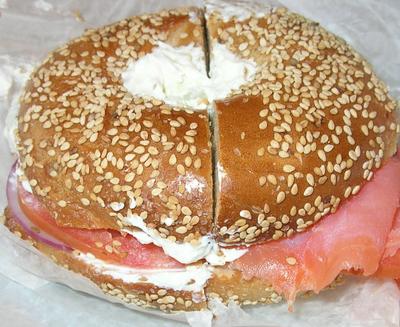
RESTAURANT: Murray’s Bagels
LOCATION: 500 6th Avenue
DATE: July 30, 2005
FOOD: Multigrain Sesame Bagel with Low-Fat Scallion Cream Cheese, Smoked Salmon, Tomatoes, Capes, and Red Onions
BEVERAGE: Bottled Water
PRICE: $8.00
What’s a visit to New York without at least one bagel? So, when Libby’s sister, Bennett, and her boyfriend, Wayne, came to New York during my last weekend in New York, Saturday began with a trip to Murray’s Bagels.
Continuing on the excellence of my previous two visits, my lox and cream cheese bagel was outstanding, and hands down, the best of my three experiences. The bagel contained its typical hearty sublimetly, the cushy inside offset by the perfect tough, chewy exterior. However, the smoked salmon was what made this visit outshine my others. Nearing the perfection of Russ and Daughter’s expertly cured seafood, Murray’s smoked salmon was fresh and crisp, the type of fish usually found only near fresh water ports. Whereas many smoked salmons are ruined by oversalting, Murray’s had the prefect level of sodium dense luxury. That I could even get low fat scallion cream cheese to enhance the pungent flavors in the salmon, capers, and onions, made this an ideal breakfast. Though being a tour guide is seldom fun, at least in this instance, it meant I got to eat well.
RATING: 8.5/10
Restaurant 60: Alto

Clockwise from top left: Polenta; Gnocchi; Peach Strudel; Guinea Hen.
RESTAURANT: Alto
LOCATION: 520 Madison Ave.
DATE: July 28, 2005
FOOD: Four Course Dinner Prix Fixe: Polenta Integrale – Chanterelle mushrooms, white asparagus, braised lumache & preserved truffles; Potato-Spinach “Stran golapreti” – ricotta and potato gnocchi with rabbit “en civel” shaved parmigiano; Guinea Hen – “poached” breast, roasted leg, foie gras emulsion, speck & haricot verts; Peach Strudel – vanilla custard and fresh blueberries; Additional Cheese Plate: Brunet: goat’s milk – Piedmont crystallized rosemary, apple and pinenuts; Hoch Ybrig: cow’s milk, Ybrig, Switzerland – caraway and shallot marmalade with fennel salad
BEVERAGE: Glass of Proseco; Split a bottle of red wine
PRICE: $145.00
L’Impero wasn’t enough. For, Scott Conant, all heady youth, ambition dripping like purified olive oil, it was time to make the next jump. He wanted his fourth star. Thus, Alto was born, a restaurant set on transforming Italian food by adding the influences of German cuisine.
And by all accounts, Conant is close – close but still not quite there.
Alto has all the trappings of the traditional four stars: smooth, knowledgeable service; creative presentation; a menu with as many languages and cultural influences as Mario Batali has restaurants. Yet, Alto is still young, still in need of the refinement only time and countless repetitions can bring.
The four course dinner prix fixe is a bargain by New York standards at $72. Including three savory courses and a dessert, it follows the same model Conant made popular at L’Impero. However, it’s not just the two menu’s structures that show similarities; the offerings also nod towards one another. At L’Impero, Conant’s polenta with mushrooms has become the stuff of legends. At Alto, he adjusts the dish, adding escargot, truffles and white asparagus, while maintaining the brilliant coupling of grain and mushroom. Alto’s polenta appetizer was soft and fluffy, delicious and complex. When a bite took in all the dish’s ingredients, the taste was magnificent, the earthy chew of the mushrooms mixing with the saltiness of snail and polenta to dazzling effect. Yet, the polenta itself lacked the creamy resplendence to stand on its own which made L’Impero’s polenta as memorable as it was. At Alto, the whole worked, but the components equaled something far less great.
The same frustrating case of stunted development hindered the gnocchi course from reaching its full explosiveness. The large, spinach gnocchi were sensational on their own. So too, the tender meat of the rabbit. But while deconstructed dishes may be all the rage, at least for a pasta course, its better to build than tear down. With a presentation evoking sushi, the gnocchi was a disparate blend of flavors. A more traditional cohesion of the rabbit and gnocchi (and a sauce of some kind instead of shaved parmigiano) would have reduced the austerity and seeming overly ornate-ornateness of the potato dumplings. Whereas with the polenta individual aspects needed to be improved to survive on their own, with the gnocchi it was the cohesion that was lacking.
However, when it came to the guinea hen, Conant left no reason to question his methods. Inverting the traditional roasted chicken, Conant injected the guinea hen with a stuffing of almonds and currants before covering it in a foie gras foam, the taste of which are testimony enough of the chef’s prestigious talents. Cloudlike in texture, the emulsion was densely packed with a rich and intriguing smokiness. As he did with the rabbit in the gnocchi course, Conant mixed light and dark meats of the same bird, presenting the diner with an entire spectrum of flavors in the same dish.
The peach strudel was the only true disappointment of the evening. Sweet and enjoyable, it was far too simple for a restaurant attempting to push the boundaries of traditional cuisine. It was the type of excellent strudel easily found at unassuming German restaurants throughout the city or any Milwaukee bakery. But, with the bar set high during the rest of the meal, it was a let down for dessert to be so normal.
And as convivial as the service was, there are still kinks at Alto no four star restaurant would and can permit. One instance occurred when the cheese course was brought at the same time as dessert, with a complete disregard for adequate spacing. It meant either the ice cream melted or the cheese, better prior to dessert than after, had to wait until later.
So Alto isn’t there yet. It may have the petit-fours, but it doesn’t have the grace of a Le Bernardin or the class of a Per Se. Conant is trying to scale a German sized Alp and is having some technical difficulties on the way to the apex. But if Conant’s success at L’Impero is any indication, there’s little doubt that given a little time, Alto will start rising to the heights its name suggests. And who knows what Conant will think to do then.
RATING: 8.0/10
Wednesday, August 03, 2005
Restaurant Remix 3: Babbo
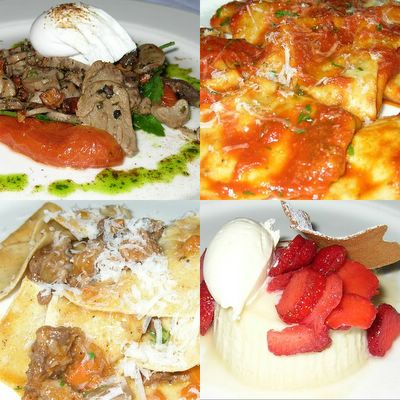
Clockwise from top left: Warm lamb's tongue; Duck tortelli; Italian cheesecake; Pappardelle with pork ragu.
 RESTAURANT: Babbo
RESTAURANT: BabboLOCATION: 110 Waverly Place
DATE: July 26, 2005
FOOD: Sauteed Chickpeas (complimentary); Warm Lamb's Tongue Vinaigrette with Hedgehogs, and a 3-Minute Egg,; Roasted Potatoes; Spaghettini with Spicy Budding Chives, Sweet Garlic and a One Pound Lobster; Pappardelle with Pork Ragu; Homemade Orecchiette with Sweet Sausage and Rapini; Duck Tortelli with “Sugo Finto”; Italian Ricotta Cheesecake.
BEVERAGE: Split a bottle of red wine; Decaf Cappuccino
PRICE: $81.00
Is it possible to over-eat a good thing? Is it possible that the pleasure and excitement of a particular restaurant’s food will be lessened if dined upon one too many times? In the case of Babbo, the answer is clearly, unequivocally, and a forthrightly screamed NO! Unless you were born sans pasta taste buds, Babbo’s cuisine is like the Bloc Party and Rolling Stones albums that play in the restaurant, in that both the food and the music never get old.
Danny and his friend Brian joined Alex and I for a pasta tasting menu of our own creation. However, before we sampled semolina like it was our jobs, we started with the appetizer Danny had been fascinated with for weeks. The warm lamb’s tongue vinaigrette was every bit as evocative, singular and palate shattering as we’d hoped it be. The lamb’s tongue tasted more like mushrooms than meat, the tongue so tender that chewing really wasn’t required. Once the gushing yoke of the quail egg had been released by the prick of my fork, an entire new element of creamy richness was added to the more subtle acidic fangs of the vinaigrette. As a whole, the dish certainly ranks up there as not only one of the most unique appetizers in my New York dining experience, but also as one of the best.
However, we had come for pasta and it was pasta we would have. Like one of Umberto Eco’s monks in The Name of the Rose desperately trying to avoid the temptation of the flesh, so too did I ward off the desire to once again revel in the majesty of the black spaghetti and beef cheek ravioli that Danny, Alex, and Brian split. My restraint was rewarded by the tastes of four previously untried pastas. The first, the duck tortelli, was an amazing take on meat filled ravioli. The overly fatty nature of duck was well utilized in the tortelli, as in such specific amounts, the duck’s fascinating mix of poultry and lamb flavors was allowed to shine through. The tomato base saucing was superb and of course, the pasta itself was as soft and pliant as an Italian maiden’s bosom (or at least what I would assume an Italian maiden’s bosom would feel like, having never experienced it myself, I can only guess, which is a sad reality, an oh, so, so sad reality).
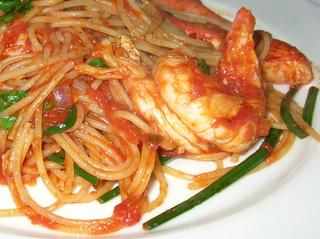 Next came the spaghettini with a full pound lobster. Possessed by the same spicy complexity that makes the black spaghetti such a successful mix of ingredients, the budding chives and heavily applied garlic combined to make the pasta just as decadent as fresh lobster dripped in butter, but with an edge. It would be hard to imagine lobster better used in pasta. Just as masterful was the pappardelle with pork ragu, the lasagna like noodles providing the wide berth needed to support the density of the stewed pork. Like all of Batali’s dishes, the meat was astoundingly prepared and when topped with grated cheese the sensation was pure bliss.
Next came the spaghettini with a full pound lobster. Possessed by the same spicy complexity that makes the black spaghetti such a successful mix of ingredients, the budding chives and heavily applied garlic combined to make the pasta just as decadent as fresh lobster dripped in butter, but with an edge. It would be hard to imagine lobster better used in pasta. Just as masterful was the pappardelle with pork ragu, the lasagna like noodles providing the wide berth needed to support the density of the stewed pork. Like all of Batali’s dishes, the meat was astoundingly prepared and when topped with grated cheese the sensation was pure bliss.Last, but certainly not least was the orecchiette with sw
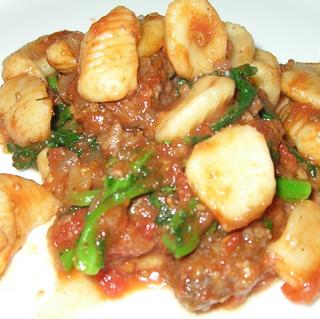 eet sausage and rapini. Anytime a dish is composed of three ingredients that are heavenly on their own, it’s a good bet the combination will end in a collaboration of momentous affect. The rapini had a lovely garlic hue, while the sweet sausage merged sublimely with the sugar of the tomatoes. Contrasting all the soft textures was the firm, chewy nature of the orecchiette, served authentically al dente. As we polished every last trace of pasta from the plates before us, it was only natural to sit back and gasp at the wonder we had experienced. Mario just continues to amaze.
eet sausage and rapini. Anytime a dish is composed of three ingredients that are heavenly on their own, it’s a good bet the combination will end in a collaboration of momentous affect. The rapini had a lovely garlic hue, while the sweet sausage merged sublimely with the sugar of the tomatoes. Contrasting all the soft textures was the firm, chewy nature of the orecchiette, served authentically al dente. As we polished every last trace of pasta from the plates before us, it was only natural to sit back and gasp at the wonder we had experienced. Mario just continues to amaze.While none of us were hungry at that point, in what seemed an effort to prolong the meal and keep the evening from ending, we ordered a round of desserts. My selection, the Italian ricotta cheesecake was exactly how cheesecake should be. Instead of the American version in which the over application of cream cheese leads to an inducement of stomach turning gravity, Babbo’s cheesecake was more like composed whipped cream. The fresh strawberries hinted at sabayon and supplied a lighter finish for a night filled with the hearty satisfaction only luminous pasta (and there’s none been than Babbo’s) can bring.
Even after two visits within two weeks, I still wanted to go to Babbo again. But while this desire will have no capacity to be quelled any time in the near future, I’m at least mildly contented by the fact that I tried all the pastas on the menu that intrigued me most. Hopefully by the next time I’m in New York, Mario will have let his creative side out once again, and there will be plenty of new raptures to try. Until then, mangia on Mario. Mangia on.
RATING: 10/10
Book 17: Extremely Loud and Incredibly Close, by Jonathan Safran Foer (Infinite Feast XXII)

Hardcover: 368 pages
Publisher: Houghton Mifflin (April 4, 2005)
After he published Catch-22 in 1961 until his death in 1999, the duration of Joseph Heller’s literary career was spent trying to live up to the notoriety and achievement of his first novel. Critics generally only offered back-handed, watered down compliments, always engaging in a comparison to his first masterpiece.
Such situations are not uncommon to any artistic field, least of all the literary community. Thus, that just three years after he garnered world-wide acclaim for Everything is Illuminated, 26 year old and Brooklyn resident Jonathan Safran Foer published his second novel is at once an extremely courageous and an incredibly naïve move. The novel, Extremely Loud and Incredibly Close, has all the same humor and pseudo avant-garde stylistics that made his first novel so successful. In fact, Extremely Loud and Incredibly Close is probably exactly what most of Foer’s fans sought from him – but it was exactly what he shouldn’t have given them.
Extremely Loud and Incredibly Close follows the impertinent but loveable Oskar Schell, a nine-year old whose business card lists his occupations as inventor, jewelry designer, jewelry fabricator, amateur entomologist, Francophile, vegan, origamist, pacifist, percussionist, amateur astronomer, computer consultant, and collector of rare and other things. That Oskar is a jack of all trades but master of none is an appropriate metaphor for Foer’s novel as a whole: just as his character dabbles in everything but excels at nothing, so does Foer produce a inconsistent and at times frustrating second effort that will leave casual readers smiling, while more demanding readers will be left wondering if Foer has regressed, bought too much into his own hype, or if Everything Is Illuminated wasn’t that good to begin with.
Oskar’s father died in the 9/11 World Trade Center terrorist act. The novel rotates around Oskar’s unmitigated pain at the loss and his search to find some way to keep the memory of his father alive. He begins a search across all of New York in an attempt to hunt down the answer to a mysterious key he finds hidden in his father’s closet. Along the way he meets a host of magical realistic characters, some of which are charming and endearing, while others are just downright annoying.
That inconsistency is the greatest flaw of Extremely Loud and Incredibly Close. The same schizophrenia that overwhelms Oskar’s thoughts so too consumes Foer’s writing. The novel at times is extremely entertaining and incredibly moving, as when Oskar hits on an older woman or throws in random French phrases accrued from his private lessons. But the novel is undercut by a conventional and predictable plot, replete with sappy storylines, melancholic indulgences and a general bogarting of the 9/11 tragedy’s power for its own sentimental artistic means. There’s a disingenuous sub-thread running through the novels pages that a good editor would have picked out.
Foer throws in literary allusions like he’s name dropping at an exclusive night club. Oskar is clearly an homage to the lead character of Gunter Grass’s Tin Drum, but did Foer’s Oskar really have to carry a tambourine everywhere he went to mimic Grass’s drum playing renegade? Haphazard touches like this abound in Extremely Loud and Incredibly Close and it causes the reader to wonder whether Foer is paying homage to literary forerunners, or just self-promoting himself as ex
 tremely well-read and incredibly smart. There’s no deftness to the allusions, only a hodge-podge of rather loosely related references.
tremely well-read and incredibly smart. There’s no deftness to the allusions, only a hodge-podge of rather loosely related references.But the allusions would only be a minor detraction if the rest of the novel were better. And while Foer certainly uses mixed-media effectively in some places, he’s often too cute by half and much less original than he realizes. Yes the novel is broken up with pictures of everything from the collapse of the towers to the Staten Island Ferry crash, and these splices often carry great emotional gravity, but Ishmael Reed did the same thing in a much more inventive way in Mumbo Jumbo, all the way back in 1971. And Foer seems to throw some pictures in at random. What made Everything Is Illuminated so delightful was that Foer was able to create his own atmosphere and emotion. In Extremely Loud and Incredibly Close, its certainly questionable whether we feel for Oskar because Foer’s writing evokes us to, or because the 9/11 event is so charged with emotion on its own.
There are historical sideshows as well, which seem forced and heavy handed. Oskar’s grandparents survived the Dresden bombing and therefore, this enables Foer to link 9/11 to a grander picture of war as pure futility. Oskar makes a report on Hiroshima to his class as well, yet again invoking another catastrophe. But just as the literary allusions often fell short, so too do these rather historically shallow connectors come up short. In trying to show how all wars are similar in their pointlessness and wasted bloodshed, Foer glosses over the differences and complexities of conflict and the world in general, which leave any historically minded reader disappointed and suspect of Foer’s historical veracity. He seems more committed to writing a book fit for Hollywood production, than a well researched and thoroughly thought out narrative. At moments, Foer seems to be pandering to a Ron Howard like audience, ready for the next uplifting, Beautiful Mind scene to set them on their way.
Extremely Loud and Incredibly Close is certainly worth reading and any frustration towards Foer comes only out of the fact that he is indeed an extremely talented and incredibly gifted writer. But just as The Life Aquatic revealed aspects of Wes Anderson’s aesthetic that were false and rather sappy, so too does Foer’s second novel reveal a tendency to rely more on gimmick than substance. Whereas Heller produced many novels after Catch-22 that were art in their own-right, hopefully Foer will exceed the promise of Everything Is Illuminated and progress into all new literary territory. Extremely Loud and Incredibly Close shows that he’s standing still at the moment, but his youth gives ample grounds for thinking he might fully reach his future promise.
Restaurant Remix 2: Veselka
 RESTAURANT: Veselka
RESTAURANT: VeselkaLOCATION: 144 2nd Avenue
DATE: July 24, 2005
FOOD: Deluxe Meat Combination Plate (with substitutions) – Cup of Lentil Soup; Salad; 1 Meatless Stuffed Cabbage; Grilled Kielbasa; 1 Spinach and Cheese, 1 Sweet Potato, 1 Sauerkraut and Mushroom Pierogies. Dessert – Pear, Blueberry and Almond Tart a la Mode; Sticky Bun; Chocolate Cupcake.
BEVERAGE: Tap Water; Decaf Coffee
PRICE: $29.00
Old habits die hard. Or perhaps, old habits are really old friends and they shouldn’t die at all. While new experiences are all well and good, when it comes to comfort food, especially late night comfort food, novelty just isn’t an option. Thus, while a disappointing Bigos experience had left me wondering whether to return to Veselka, my late night standby, in the end, I knew I couldn’t leave New York without one more trip to the 24 hour East Village Ukranian.
Veselka deserved another chance. It had provided more than enough memories to warrant my forgiveness. From our first drunken gorging, to less intoxicated discussions on life’s complexities, to more drunken binges (including one following a meal at WD-50 that would be impossible for me to forget), Veselka has been Danny and my stand-by, the place we affectionately refer to as “our place”. Outsiders have accompanied us, but on our final visit, it was only the two of us and all our New York reminiscences.

On such a memory ridden, and somewhat bittersweet occasion, I had no intention of ordering anything new. I was returning to my Veselka favorites – the hearty Ukranian fare that sticks to the ribs and lasts even the longest of winters. I might not be a hunter (and have ideological qualms with the activity in general), but that wasn’t going to stop me from eating like one.
So with all the difficulty of Meg Ryan’s Sally in When Harry Met Sally, I ordered the Deluxe Meat Combination Plate, only to substitute until all of the beef items had been replaced by their corresponding vegetable renditions (I wanted the kielbasa – somehow pork is okay). I was bringing in scabs, but I didn’t care. All that mattered was that the job of feasting got done.
The lentil soup starter was thick, only lightly salted, and most importantly, fresh. Unlike canned lentil soups (Progresso, I’m looking in your direction) Veselka’s soup could in no way be called watery. The house salad, with a tangy lemon and dill vinaigrette was equally simple and equally delicious. It was the type of no nonsense cuisine that endeared Veselka to me in the first place.
But then came the gist of the order. A meatless stuffed cabbage, covered in white mushroom gravy, was a viable alternative to its meat filled cousin. The cabbage was crisp instead of limpid, the rice and ground vegetable filling creating a surprisingly light take on a dish traditionally as heavy as Ukranian snowfall. The kielbasa was tender with a crusty skin providing a pleasant chew. And of course, the pierogies, the tasty dumplings that Veselka seems to do better than anyone else. The sweet potato is perhaps the best, an unadulterated filling complimenting its familial, unsweetened brethren, used as the wrapping.
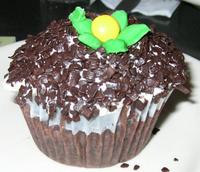
However, the meal was far from over. Ever since our first visit last June, Veselka has gained in stature in the minds of both Danny and myself largely because of its desserts. Pierogies are all well and good, but a dumpling can’t touch my sweet tooth fit for a saber-toothed tiger. Thus, in accordance with so many past gluttonies come and gone, I ordered a three course dessert mania that would have left even Jacques Torres speechless. I had tried the banana and vanilla cupcakes on previous Veselka splurges, but the chocolate cupcake surpassed both of these for moistness and flavor. The icing had the perfect restrained sweetness I desire in a cupcake. And as the night was about old friends, I found great solace in the sticky bun, lacquered with enough pecans to make a pie, the pastry, akin to the cupcake, was soft and moist. The caramel coating was sugary enough to be a dessert, but mild enough for breakfast. But the hands down winner of the impromptu dessert competition was the pear and blueberry tart, an unexpected innovative turn from the Veselka bakery. While the blueberries should have been better integrated into the rest of the tart’s damp, fruity texture, the tart was half cake, half pie, and completely wonderful.
Thus, while it might have been our last visit to Veselka, it was one of the best. Even as melancholy feelings melted within me like the ice cream a la mode on my tart, I was heartened that Veselka was there, everyday, 24 hours a day, open and consistent. It might take a while for me to get back to New York, but oddly, its reassuring to know that no matter where I am, Veselka will be open and waiting for one more late night bout of revelry.
RATING: 7.8/10